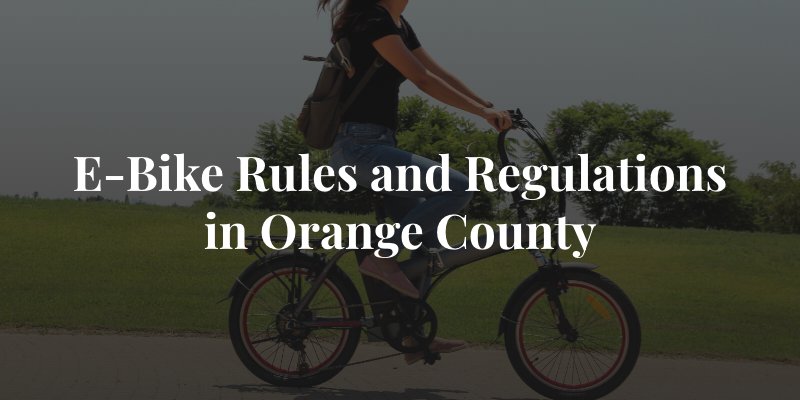Electric bikes, or e-bikes, have become a more popular way to get around thanks to rentable e-bikes being made widely available to the public. Many cities in Orange County and throughout Southern California have fleets of e-bikes available to rent from companies such as Lime, Uber and Zoomo. Understanding the laws that apply to e-bikes in Orange County can help you navigate these vehicles (or around them) more safely. In the event of an accident, our Orange County injury attorneys can help.

Where Can E-Bikes Be Ridden?
E-bike riders have the same rights to ride on public roads as motor vehicle drivers. In most jurisdictions, electric bicycles are not permitted to be ridden on sidewalks. They must be ridden on the road in the same direction as the flow of traffic. E-bike riders should keep to the right-hand side of the road as much as possible except when making a left turn or avoiding roadside hazards.
E-bikes can share a lane with fellow bicyclists but may not share a single lane with a passenger vehicle. If a passenger car wishes to pass an E-bike, it must keep at least three feet of distance between the vehicle and e-bike. Under California’s lane-splitting law, E-bike riders are permitted to ride on the line between two lanes of same-direction traffic. However, they should do so only when surrounding traffic is traveling at low speeds.
Can E-Bikes Be Used in Bike Lanes?
Class 1 and 2 E-bikes can be operated on all bike access routes including:
- Bike paths
- Bike lanes
- Bike routes
- Protected lanes
Class 3 E-bikes, however, can ride on all these paths aside from bike paths. Bike paths are described as off-street paved paths that are shared with foot traffic, skates, skateboards, etc.
E-Bike Classifications in California
Class 1:
- Pedal-assist only
- Maximum assisted speed of 20 mph
- No throttle
Class 2:
- Pedal-assist or throttle
- Maximum assisted speed of 20 mph
Class 3:
- Pedal-assist only
- Maximum assisted speed of 28 mph
Age Restrictions
Only riders over the age of 16 may operate a class 3 electric bicycle. This restriction does not apply to class 1 or class 2 e-bikes. Note, however, that the rider does not need a driver’s license.
Helmet Law Varies Depending on Age and Classification of E-Bike
Helmets are required by riders who are 17 years old and younger on class 1 and 2 e-bikes. They are required for all ages on class 3 e-bikes. Even if you are not legally required to wear a helmet on an electric bicycle, you should do so for your own safety. Accidents involving e-bikes can be catastrophic and result in serious injuries, including permanent or fatal traumatic brain injuries. Wearing a helmet can drastically decrease the risk of suffering a severe head or brain injury in a bike accident.
Biking Under the Influence
In California, driving under the influence or DUI law applies to all motor vehicles, including those that are self-propelled. This means that operating an electric bicycle while impaired by drugs and/or alcohol could lead to a standard DUI charge. It is against the law to operate an e-bike with a blood alcohol concentration (BAC) level at or above 0.08. California’s Zero Tolerance law also bans a rider or driver under the age of 21 from operating a motor vehicle with a BAC at or above 0.02 percent.
Who Pays for an E-Bike Accident?
California’s fault-based insurance law applies to collisions involving electric bikes. The person or party most at fault for causing the e-bike accident will be held financially responsible. It is the victim’s responsibility to prove fault to receive benefits from the at-fault party’s insurance provider. Otherwise, the e-bike rider may have to pay for his or her own medical bills and damages through first-party insurance or out of pocket.
If you get injured in an e-bike accident in Southern California, contact an Orange County personal injury lawyer to help you recover fair compensation.
